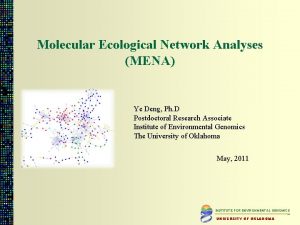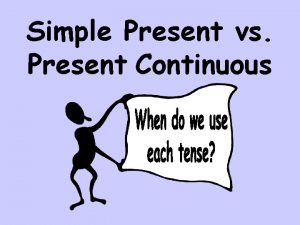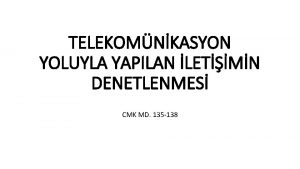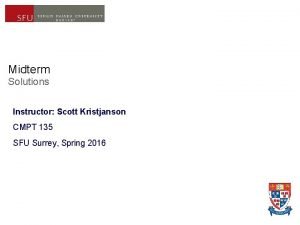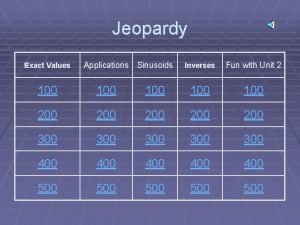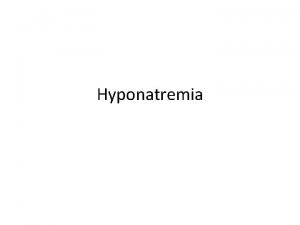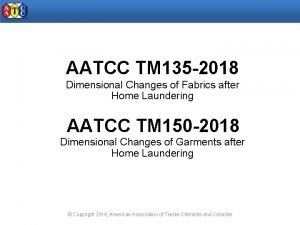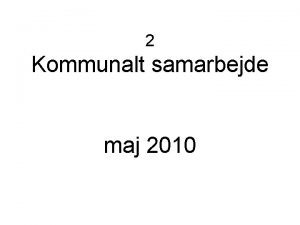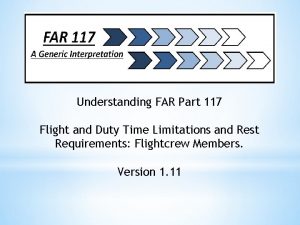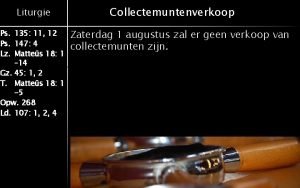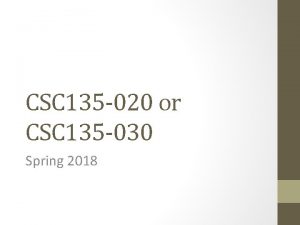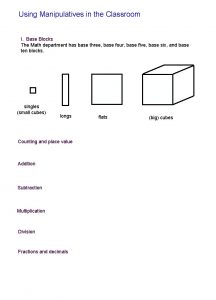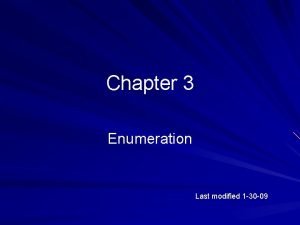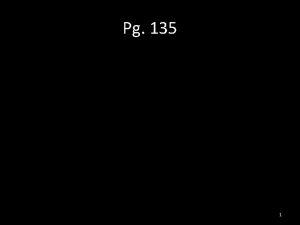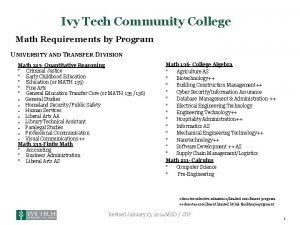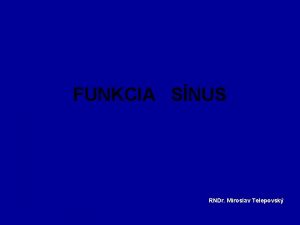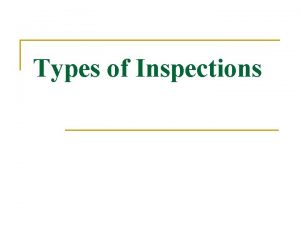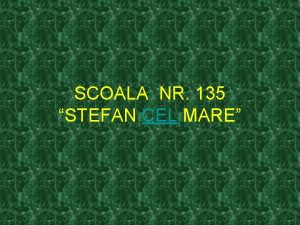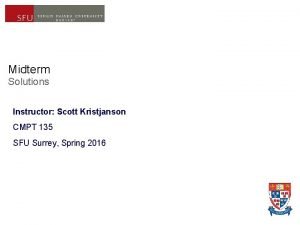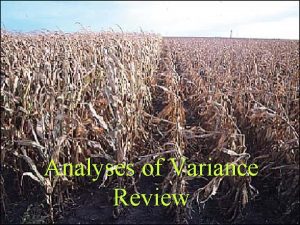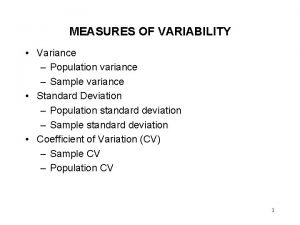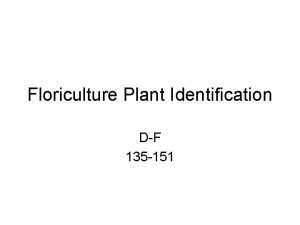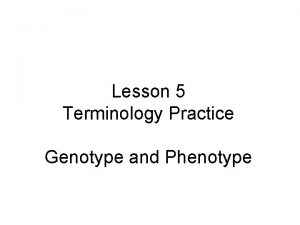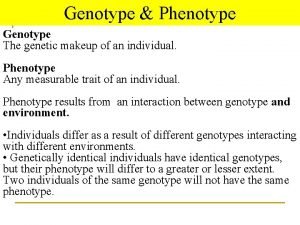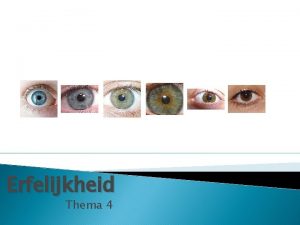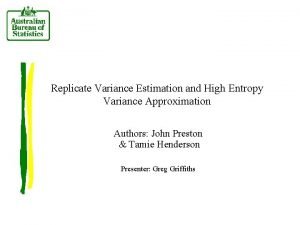Analyses of Variance Simple Situation Genotype A 135




![t-test |x 1 -x 2| t= 2[( 12+ 22)/(n 1+n 2)] t-test |x 1 -x 2| t= 2[( 12+ 22)/(n 1+n 2)]](https://slidetodoc.com/presentation_image/3817f8a4a45d7823e4dd309595d231bb/image-5.jpg)






































![Checking ANOVA Accurucy v Coefficient of variation: [ e/ ]x 100. v CV=(√ 100. Checking ANOVA Accurucy v Coefficient of variation: [ e/ ]x 100. v CV=(√ 100.](https://slidetodoc.com/presentation_image/3817f8a4a45d7823e4dd309595d231bb/image-44.jpg)

- Slides: 45

Analyses of Variance

Simple Situation Genotype A 135 Genotype B 34

Simple Situation Genotype A 135 115 102 110 115. 5 Genotype B 34 76 83 64 64. 2

Observations and Questions v From the replicated means, genotype A is “better” than genotype B. v What is the probability that this result will be repeated if this test were done say 100 times? v Could this result have occurred by random chance?
![ttest x 1 x 2 t 2 12 22n 1n 2 t-test |x 1 -x 2| t= 2[( 12+ 22)/(n 1+n 2)]](https://slidetodoc.com/presentation_image/3817f8a4a45d7823e4dd309595d231bb/image-5.jpg)
t-test |x 1 -x 2| t= 2[( 12+ 22)/(n 1+n 2)]

t-test Replicate 1 2 3 4 5 6 Genotype Stephens Lambart 55 78 66 91 49 97 64 82 70 85 68 77

Replicate Genotype Stephens Lambart 1 2 3 4 5 6 55 66 49 64 70 68 78 91 97 82 85 77 x mean x 372 62 510 85

Replicate Genotype Stephens Lambart 1 2 3 4 5 6 55 66 49 64 70 68 78 91 97 82 85 77 x mean x x 2 ( x)2/n SS(x) 372 62 23, 402 23, 064 338 510 85 43, 652 43, 350 302

Replicate Genotype Stephens Lambart 1 2 3 4 5 6 55 66 49 64 70 68 78 91 97 82 85 77 x mean x x 2 ( x)2/n SS(x) df 372 62 23, 402 23, 064 338 5 510 85 43, 652 43, 350 302 5 2 76. 6 60. 4

t-test Stephens = 62 bushels Lambart = 85 bushels Significant?

t-test Stephens = 62 bushels Lambart = 85 bushels |x. Stephens-x. Lambart| t= 2[( St 2+ La 2)/(n. St+n. La)] t = |85 -62|/ 2[(60+77)/12] = 4. 82 cw t 10 df : exceeds 99% table value

More than two treatments Rep. Genotype Brundage Lambert Croft Stephens 1 64 78 75 55 2 3 4 5 6 72 68 77 56 95 91 97 82 85 77 93 78 71 63 76 66 49 64 70 68

Multiple t-tests v Brundage v Lambert; Brundage v Croft; Brundage v Stephens; Lambert v Croft; Lambert v Stephens; Croft v Stephens. v Problems? v If all tests were done at 95% significance level, and one difference was significant, we have done 6 tests and would expect 1/20 to be significant, at random.

More than two treatments # x x Genotype Brundage Lambert 432 72 510 85 Croft Stephens 456 76 372 62 Total 1, 770 295

More than two treatments # x x x 2 ( x)2/n ss(x) df Genotype Brundage Lambert 432 72 31, 994 31, 104 890 5 510 85 43, 652 43, 350 302 5 Croft 456 76 35, 144 43, 656 488 5 Stephens Total 372 1, 770 62 295 23, 402 134, 192 23, 064 132, 174 338 2, 018 5 20

More than two treatments # x x x 2 ( x)2/n ss(x) df 2 Genotype Brundage Lambert 432 72 31, 994 31, 104 890 5 178. 0 510 85 43, 652 43, 350 302 5 60. 4 Croft 456 76 35, 144 43, 656 488 5 97. 6 Stephens Total 372 1, 770 62 295 23, 402 134, 192 23, 064 132, 174 338 2, 018 5 20 76. 6 100. 9

Analysis of Variance v From pooled variance we can estimate a pooled SED between any two means = (2)(100. 9)/6 = + 5. 80, and use this in all t-tests. v Alternatively an analysis of variance could be carried out. v This form of analysis was first proposed by Fisher in the 1920’s

Analysis of Variance v Is an elegant and quicker way to calculate a pooled error term. v Analysis is simple in simple designs but can be complicated and lengthy in some designs (i. e. rectangular lattices). v In some experimental designs the ANOVA is the only method to estimate a pooled error term.

Analysis of Variance v It can provide an F-test to tests specific hypotheses. (i. e. to test general differences between different treatments). v Can be an invaluable initial contribution to interpretation of experiments.

Theory of Analysis of Variance v Consider a simple CRB design. v Four treatments (n = 4). v With all treatments replicated 5 times (k = 5). v The total experiment would be n x k = 20 experimental units.

Theory of Analysis of Variance Rep. 1 2 3 4 5 A x 11 x 12 x 13 x 14 x 15 Treatment B C x 21 x 31 x 22 x 32 x 23 x 33 x 24 x 34 x 25 x 35 D x 41 x 42 x 43 x 44 x 45

Theory of Analysis of Variance Rep. 1 2 3 4 5 A x 11 x 12 x 13 x 14 x 15 Treatment B C x 21 x 31 x 22 x 32 x 23 x 33 x 24 x 34 x 25 x 35 D x 41 x 42 x 43 x 44 x 45 Mean x. 1 x. 2 x. 3 x. 4 x. 5

Theory of Analysis of Variance Rep. 1 2 3 4 5 Mean A x 11 x 12 x 13 x 14 x 15 x 1. Treatment B C x 21 x 31 x 22 x 32 x 23 x 33 x 24 x 34 x 25 x 35 x 2. x 3. D x 41 x 42 x 43 x 44 x 45 x 4. Mean x. 1 x. 2 x. 3 x. 4 x. 5 x. .

Theory of Analysis of Variance TSS = i j(xij-x. . )2 TMS = i j(xij-x. . )2/(nk-1) i j(xij-x. . )2 = i j[(xij-xi. ) + (xi. -x. . )]2 i j[(xij-xi. )2+2(xij-xi. )(xi. -x. . )+(xi. -x. . )2]

Theory of Analysis of Variance i j[(xij-xi. )2+2(xij-xi. )(xi. -x. . )+(xi. -x. . )2] 2 i j(xij-xi. )(xi. -x. . ) i[2 n (xi. -x. . ) j(xij-xi. )] But! j(xij-xi. ) = 0 2 i j(xij-xi. )(xi. -x. . ) = 0

Theory of Analysis of Variance i j[(xij-xi. )2+2(xij-xi. )(xi. -x. . )+(xi. -x. . )2] i j[(xij-xi. )2 + (xi. -x. . )2] i j(xij-x. . )2 = i j(xij-xi. )2+k i(xi. -x. . )2] k i(xi. -x. . )2 = Between Treatment SS i j(xij-xi. )2 = Within Treatment SS

Theory of Analysis of Variance k i(xi. -x. . )2 = Between Treatment SS i j(xij-xi. )2 = Within Treatment SS df [WTSS] = nk-n : df [BTSS] = n-1 MS = SS/df WTMS ~ 2 nk-n df : BTMS ~ 2 n-1 df

Theory of Analysis of Variance WTMS ~ 2 nk-n df : BTMS ~ 2 n-1 df Yij = + gi + eij gi = BTMS : eij = WTMS Assumption is homogeneity of error variance between treatments.

Theory of Analysis of Variance Source of variation df EMS Between treatments n-1 e 2 + k t 2 Within treatments Total nk-n e 2 nk-1 [ e 2 + k t 2]/ e 2 = 1, if k t 2 = 0

Analysis of Variance of CRB Source Between treatments Within treatments Total df SS k-1 [G 12/n 1 + G 22/n 2 … Gk 2/nk] - CF jk-k By difference jk-1 [x 112 + x 122 + … + xjk 2] - CF CF = [ xij]2/jk

More than two treatments Rep. Genotype Brundage Lambert Croft Stephens 1 64 78 75 55 2 3 4 5 6 72 68 77 56 95 91 97 82 85 77 93 78 71 63 76 66 49 64 70 68

More than two treatments Genotype # Brundage Lambert x x 432 72 510 85 Croft Stephens 456 76 372 62 Total 1, 770 295 CF = ∑(64 + 72 + 68 +. . + 68)2/24 TSS = ∑(642 + 722 + 682 +. . + 682) - CF BSS = ∑(4322/6 + 5102/6 + 4562/6 + 3722/6) - CF WSS = TSS - BSS

More than two treatments # x x Genotype Brundage Lambert 432 72 510 85 Croft Stephens 456 76 372 62 Total 1, 770 295 CF = ∑(64 + 72 + 68 +. . + 68)2/24 TSS = ∑(642 + 722 + 682 +. . + 682) - CF BSS = ∑(4322 + 5102 + 4562 + 3722)/6 - CF WSS = TSS - BSS

More than two treatments Genotype # Brundage Lambert x x 432 72 510 85 Croft Stephens 456 76 372 62 Total 1, 770 295 CF = ∑(64 + 72 + 68 +. . + 68)2/24 TSS = ∑(642 + 722 + 682 +. . + 682) - CF BSS = ∑(4322/6 + 5102/6 + 4562/6 + 3722/6) - CF WSS = TSS - BSS

Example of Analysis of Variance Source df SS MS F Between genotypes 3 1636. 5 545. 5 5. 41** Within genotypes 20 2018. 0 100. 9 Total 23 3654. 5 ** = 0. 01 > P > 0. 001

Analysis of Variance of CRB Rep. 1 2 3 4 5 A x 11 x 12 x 13 - Treatment B C x 21 x 31 x 22 x 32 x 23 x 33 x 24 x 35 D x 41 x 42 x 43 x 44 -

Analysis of Variance of CRB Rep. 1 2 3 4 5 Total A x 11 x 12 x 13 G 1 Treatment B C x 21 x 31 x 22 x 32 x 23 x 33 x 24 x 35 G 2 G 3 D x 41 x 42 x 43 x 44 G 4

Analysis of Variance of CRB Rep. 1 2 3 4 5 Total A x 11 x 12 x 13 G 1 Treatment B C x 21 x 31 x 22 x 32 x 23 x 33 x 24 x 35 G 2 G 3 D x 41 x 42 x 43 x 44 G 4

Analysis of Variance of CRB Source Between treatments Within treatments Total df SS k-1 [G 12/n 1 + G 22/n 2 … Gk 2/nk] - CF jk-k By difference jk-1 [x 112 + x 122 + … + xjk 2] - CF CF = [ xij]2/jk

Assumptions behind the ANOVA v Assumption of data being normally distributed. v Homogeneity of error variance. v Additivity of variance effects. v Data collected from a properly randomized experiment.

Dealing with Wrongful Data v It is usually assumed that the data collected is correct!. v Why would data not be correct? üMis-recording, mis-classification, transcription errors, errors in data entry. üOutliers.

Dealing with Wrongful Data v What things can help? üKeep detailed records, on each experimental unit. üDecide beforehand what values would arouse suspision.

Dealing with Wrongful Data v What do you do with suspicios data? üIf correct, and it is discarded, then valuable information is lost. This will bias the results. üIf wrong and included, will bias results and may have extreme consequences.
![Checking ANOVA Accurucy v Coefficient of variation e x 100 v CV 100 Checking ANOVA Accurucy v Coefficient of variation: [ e/ ]x 100. v CV=(√ 100.](https://slidetodoc.com/presentation_image/3817f8a4a45d7823e4dd309595d231bb/image-44.jpg)
Checking ANOVA Accurucy v Coefficient of variation: [ e/ ]x 100. v CV=(√ 100. 9/73. 75)*100=13. 6% v. R 2 value = {[TSS-ESS]/TSS}x 100. v. R 2 = (1654/3654)*100 = 44. 7%. v. Compare the effect of blocking or sub-blocking (discussed later).

Next Class ANOVA of RCB Designs ANOVA of Latin Square Designs
 Time variance
Time variance Concln
Concln Importance of critical thinking in nursing process
Importance of critical thinking in nursing process Wwh set
Wwh set Courtage analyses services
Courtage analyses services Remember present simple
Remember present simple Permanent state examples
Permanent state examples Present continuous
Present continuous Psalm 135 vers 3
Psalm 135 vers 3 Cmk m.135
Cmk m.135 Ac20-135
Ac20-135 Hbu 131
Hbu 131 Sfu cmpt 135
Sfu cmpt 135 Find the exact value sec(135 degrees )
Find the exact value sec(135 degrees ) 135 meq/l
135 meq/l Fabric testing standards
Fabric testing standards 135/98 presion
135/98 presion Aatcc 150
Aatcc 150 Generel helbredsattest
Generel helbredsattest Part 117 table c
Part 117 table c Sae a-22
Sae a-22 Opwekking 268
Opwekking 268 The verb jugar (p. 208) answers
The verb jugar (p. 208) answers Hymn 135
Hymn 135 Tangens 60
Tangens 60 Csc 135
Csc 135 135 x 4
135 x 4 Jelaskan chord apa yang disusun oleh nada 572
Jelaskan chord apa yang disusun oleh nada 572 Cuál es el menor número natural
Cuál es el menor número natural 135/10 simplified
135/10 simplified Port 135 enumeration
Port 135 enumeration 180-56-56
180-56-56 Part 135 recurrent training
Part 135 recurrent training Disral
Disral Pg 135
Pg 135 Ivy tech math 136
Ivy tech math 136 Ethernet pmd
Ethernet pmd Don mann seal
Don mann seal 135+29
135+29 John carelli kutztown
John carelli kutztown Tangens 135°
Tangens 135° Exploranium gr-135 manual
Exploranium gr-135 manual 14 cfr part 135
14 cfr part 135 Factorizacion prima de 135
Factorizacion prima de 135 Cate drepte trec printr-un punct a
Cate drepte trec printr-un punct a Sfu grade distribution
Sfu grade distribution

